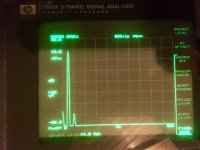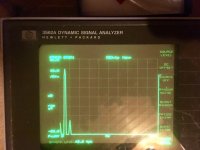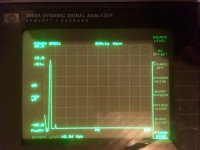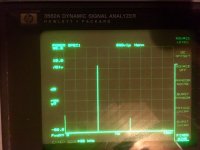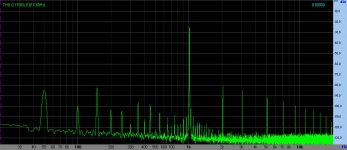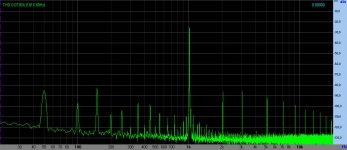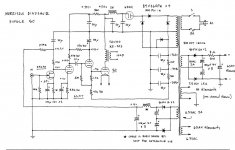Then moved to a 46 driver in hybrid mu-follower setup, unbypassed cathode resistor and a SUT of 1:8 into the 46 grid. This gives a gain of 45 and can swing 200Vpp at 0.2%. Hard to get better than that.
300B SE Amp: 46 Driver (Part II) – Bartola(R) Valves
Hi,
I find it very interesting, simplifies design and saves on parts!.
Can you please elaborate on your subjective preference for LL7903 1:8 input over 26/01A/12A input tube?.
Thanks,
HK
Last edited:
Hi Hanze
Hope you’re doing well?
It’s early for me to make a judgement on overall preference. However, I can say that I’ve been inclined on this design for a few reasons:
1. I prefer the galvanic isolation I get with the SUT and I like the sound of the LL7903. I used it before years ago and was very pleased with overall performance.
2. Like many, I try to reduce the number of valves (and overall devices) in the signal path. Yes, a SUT in exchange for a valve, but complexity and overall noise performance is improved amongst other bits.
3. With a DHT driver you can get the lowest distortion possible in the driver. Again, depends on the device. With a 47 in great shape, it can do 200Vpp at 0.12%. Mostly H2. Not many valves can get close to this performance. Obviously depending on the state of the valve a typical 47 can do anywhere between 0.12 to 0.3%.
Yes, the technical advantages have led me down this path, but ears are final judge. Before I had for a long time 3 DHTs and my preferred setup was 01a-10Y/801a into 4P1L PSE.
I like the detail I get with 2 stages. Will tell later if that’s the case after thorough listening. Unfortunately can’t do an easy swap to do quick comparison.
However, the modular driver I built allows me to test other configurations easily. I will likely get the 801a in, as would bring the thoriated tungsten sound I’m somehow miss 🙂
Cheers
Ale
Hope you’re doing well?
It’s early for me to make a judgement on overall preference. However, I can say that I’ve been inclined on this design for a few reasons:
1. I prefer the galvanic isolation I get with the SUT and I like the sound of the LL7903. I used it before years ago and was very pleased with overall performance.
2. Like many, I try to reduce the number of valves (and overall devices) in the signal path. Yes, a SUT in exchange for a valve, but complexity and overall noise performance is improved amongst other bits.
3. With a DHT driver you can get the lowest distortion possible in the driver. Again, depends on the device. With a 47 in great shape, it can do 200Vpp at 0.12%. Mostly H2. Not many valves can get close to this performance. Obviously depending on the state of the valve a typical 47 can do anywhere between 0.12 to 0.3%.
Yes, the technical advantages have led me down this path, but ears are final judge. Before I had for a long time 3 DHTs and my preferred setup was 01a-10Y/801a into 4P1L PSE.
I like the detail I get with 2 stages. Will tell later if that’s the case after thorough listening. Unfortunately can’t do an easy swap to do quick comparison.
However, the modular driver I built allows me to test other configurations easily. I will likely get the 801a in, as would bring the thoriated tungsten sound I’m somehow miss 🙂
Cheers
Ale
I second the preference for low tube count - I found 2 stages cleaner than 3. I too tried the 01A or 26 as first stage into something like a 4P1L or 1oY driver, into 300b. For a long while I settled on PSE 4P1L outputs with something like a 26 or 10Y driver to get just 2 stages. So when I went back to 300b I needed some extra gain. Where Ale chose a SUT, I chose an op-amp. Same idea of adding gain without a third tube.
I tried both the 10Y and the 46 as drivers, and I prefer the 46. This surprised me, but there we are. The 10Y is more dynamic, but the 46 is a little more subtle and neutral. I don't have any 47.
I'd certainly suggest trying an op-amp as first gain stage as a simple experiment - I like the NE5534 out of several I tried, both singles and doubles, used at 5.5x gain. Whether it rivals a LL7903 I have no way of knowing, but it may be closer than you imagine.
I tried both the 10Y and the 46 as drivers, and I prefer the 46. This surprised me, but there we are. The 10Y is more dynamic, but the 46 is a little more subtle and neutral. I don't have any 47.
I'd certainly suggest trying an op-amp as first gain stage as a simple experiment - I like the NE5534 out of several I tried, both singles and doubles, used at 5.5x gain. Whether it rivals a LL7903 I have no way of knowing, but it may be closer than you imagine.
HI Ale nice , I have the idea as a lot of dac are balanced to gain the 4v out into 1+1 to SE ..Hi
1. I prefer the galvanic isolation I get with the SUT and I like the sound of the LL7903. I used it before years ago and was very pleased with overall performance.
Cheers
Ale
«
3. With a DHT driver you can get the lowest distortion possible in the driver. Again, depends on the device. With a 47 in great shape, it can do 200Vpp at 0.12%. Mostly H2. Not many valves can get close to this performance. Obviously depending on the state of the valve a typical 47 can do anywhere between 0.12 to 0.3%. »
The 30A can do a tad better: first picture is
1khz 244v pp, loaded with ISO NC 20f, secondaries open.
Next picture is 1 kHz 283 v pp. Still between -50 and -60...
Next is 1 kHz 188v pp, and the last is 30kHz 188v pp.
As you can see distortion rises with increasing frequency, and with falling frequency. I could not find the pictures from the low frequencies.
The 30A benefits from the higher andode- cathode voltage (400v in my case)
Than the 45/47.
I am curious Ale if you observed variations in thd with rising and falling frequencies?
One of My projects this fall is to compare different driver solutions ( also by listening tests, a/b blindt/ looking forward to torture some audiofile friends...😀
3. With a DHT driver you can get the lowest distortion possible in the driver. Again, depends on the device. With a 47 in great shape, it can do 200Vpp at 0.12%. Mostly H2. Not many valves can get close to this performance. Obviously depending on the state of the valve a typical 47 can do anywhere between 0.12 to 0.3%. »
The 30A can do a tad better: first picture is
1khz 244v pp, loaded with ISO NC 20f, secondaries open.
Next picture is 1 kHz 283 v pp. Still between -50 and -60...
Next is 1 kHz 188v pp, and the last is 30kHz 188v pp.
As you can see distortion rises with increasing frequency, and with falling frequency. I could not find the pictures from the low frequencies.
The 30A benefits from the higher andode- cathode voltage (400v in my case)
Than the 45/47.
I am curious Ale if you observed variations in thd with rising and falling frequencies?
One of My projects this fall is to compare different driver solutions ( also by listening tests, a/b blindt/ looking forward to torture some audiofile friends...😀
Attachments
Last edited:
In addition to the tubes a pair of high quality Interstage transformers ...
So not a cheap solution. A nice low thd is requiered from the driverstage, but these small differences does certainly not give answer to the big question:which solution is preferred . A really cool achievement is when the cheap tubes and parts wins the competition.
soundwise. I am sure you will benefit from a larger -vg1 to cathode as performance will better. Keep posting, following your efforts are very very interesting!
So not a cheap solution. A nice low thd is requiered from the driverstage, but these small differences does certainly not give answer to the big question:which solution is preferred . A really cool achievement is when the cheap tubes and parts wins the competition.
soundwise. I am sure you will benefit from a larger -vg1 to cathode as performance will better. Keep posting, following your efforts are very very interesting!
«
3. With a DHT driver you can get the lowest distortion possible in the driver. Again, depends on the device. With a 47 in great shape, it can do 200Vpp at 0.12%. Mostly H2. Not many valves can get close to this performance. Obviously depending on the state of the valve a typical 47 can do anywhere between 0.12 to 0.3%. »
The 30A can do a tad better: first picture is
1khz 244v pp, loaded with ISO NC 20f, secondaries open.
Next picture is 1 kHz 283 v pp. Still between -50 and -60...
Next is 1 kHz 188v pp, and the last is 30kHz 188v pp.
As you can see distortion rises with increasing frequency, and with falling frequency. I could not find the pictures from the low frequencies.
The 30A benefits from the higher andode- cathode voltage (400v in my case)
Than the 45/47.
I am curious Ale if you observed variations in thd with rising and falling frequencies?
One of My projects this fall is to compare different driver solutions ( also by listening tests, a/b blindt/ looking forward to torture some audiofile friends...😀
Hey Vegard,
Nice to see this. I forgot about the EML20a I have around which I eventually get back to the mercy of my abusing tests! Surely can do as good or perhaps better
I was struggling to read the measurements on the pictures as also the fundamental isn't at 0dBFS. Anyhow seems to be above 50dB for H2 so it's good!
In my driver, the THD is flat at 0.13% up to 20kHz. Coming below 100Hz, the expected LF distortion of the SUT takes to dominate and increases up to 0.3-0.4% for 200Vpp which is still very good in my view.
High frequency distortion could be caused in your case by the transformer and the slew rate caused by the grid capacitance of the output valve. I remember you had it connected to a hefty transmitting triode!
Anyhow, there is a slight electrical advantage in the hybrid mu-follower here versus the transformer coupled as the transformer performance will play as well.
How does sounds in comparison, it's another matter as we all know.
Unfortunately I don't have much time to do many changes and experiments these days so will limit them this time to minor ones on the same topology driver.
Cheers
Ale
Some years ago I measured one of my friend's EML20a pair (CCS loaded, 150Vpp) in bread-boarded preamp.
Except of some hum (and hum induced sidebands) -due to the "naked" breadboard- , the THD was very good .. but two tubes was a little dissimilar.
Except of some hum (and hum induced sidebands) -due to the "naked" breadboard- , the THD was very good .. but two tubes was a little dissimilar.
Attachments
It’s early for me to make a judgement on overall preference.
I like the detail I get with 2 stages. Will tell later if that’s the case after thorough listening.
Hi Ale,
Thanks for the reply, I'll be interested to see where you end up. I was using 7903 as 1:4 at input of split rail input amplifier (input tube ran from +/- with plate at 0V) some time ago and was pleased with its performance, still have them on shelf. Nice thread and interesting projects.
@Andy,
Did you try JFET input as well?
Cheers,
HK
I haven't tried a JFET input. I'm not too familiar with solid state. This would require a fairly large coupling cap, would it not? No coupling cap with the op-amps.
Andy,
I always thought it would be fun to build something like this: The Trioderizer - a solid state triode
I just haven't ever had the time.
You could alter the resistor ratios to give whatever gain you are after.
I always thought it would be fun to build something like this: The Trioderizer - a solid state triode
I just haven't ever had the time.
You could alter the resistor ratios to give whatever gain you are after.
Heath Workman has produced some excellent results with a driver circuit based on an fet and EL34 with a CCS plate load.
He gets 0.025% distortion at 100 volts rms. At 30 volts and less the distortion almost disappears into the noise floor.
Tube Amps with a Twist: How to Make a Pentode Voltage Amplifier That is More Linear Than Any Triode
Steve
He gets 0.025% distortion at 100 volts rms. At 30 volts and less the distortion almost disappears into the noise floor.
Tube Amps with a Twist: How to Make a Pentode Voltage Amplifier That is More Linear Than Any Triode
Steve
Last edited:
This would require a fairly large coupling cap, would it not?
Nah. Why do you think that?
I've looked at various JFET single stages and they all seem to have a coupling cap of anything up to 10uF. Can you point me to a JFET stage with no coupling cap?
- Home
- Amplifiers
- Tubes / Valves
- 300B SE with a DHT driver
